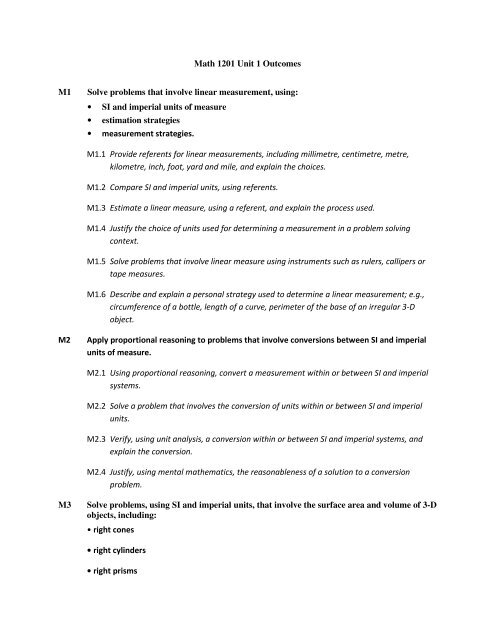Math 1201 Unit 1 Outcomes M1 Solve problems that involve linear ...
Math 1201 Unit 1 Outcomes M1 Solve problems that involve linear ...
Math 1201 Unit 1 Outcomes M1 Solve problems that involve linear ...
You also want an ePaper? Increase the reach of your titles
YUMPU automatically turns print PDFs into web optimized ePapers that Google loves.
<strong>Math</strong> <strong>1201</strong> <strong>Unit</strong> 1 <strong>Outcomes</strong><br />
<strong>M1</strong> <strong>Solve</strong> <strong>problems</strong> <strong>that</strong> <strong>involve</strong> <strong>linear</strong> measurement, using:<br />
• SI and imperial units of measure<br />
• estimation strategies<br />
• measurement strategies.<br />
<strong>M1</strong>.1 Provide referents for <strong>linear</strong> measurements, including millimetre, centimetre, metre,<br />
kilometre, inch, foot, yard and mile, and explain the choices.<br />
<strong>M1</strong>.2 Compare SI and imperial units, using referents.<br />
<strong>M1</strong>.3 Estimate a <strong>linear</strong> measure, using a referent, and explain the process used.<br />
<strong>M1</strong>.4 Justify the choice of units used for determining a measurement in a problem solving<br />
context.<br />
<strong>M1</strong>.5 <strong>Solve</strong> <strong>problems</strong> <strong>that</strong> <strong>involve</strong> <strong>linear</strong> measure using instruments such as rulers, callipers or<br />
tape measures.<br />
<strong>M1</strong>.6 Describe and explain a personal strategy used to determine a <strong>linear</strong> measurement; e.g.,<br />
circumference of a bottle, length of a curve, perimeter of the base of an irregular 3-D<br />
object.<br />
M2 Apply proportional reasoning to <strong>problems</strong> <strong>that</strong> <strong>involve</strong> conversions between SI and imperial<br />
units of measure.<br />
M2.1 Using proportional reasoning, convert a measurement within or between SI and imperial<br />
systems.<br />
M2.2 <strong>Solve</strong> a problem <strong>that</strong> <strong>involve</strong>s the conversion of units within or between SI and imperial<br />
units.<br />
M2.3 Verify, using unit analysis, a conversion within or between SI and imperial systems, and<br />
explain the conversion.<br />
M2.4 Justify, using mental mathematics, the reasonableness of a solution to a conversion<br />
problem.<br />
M3 <strong>Solve</strong> <strong>problems</strong>, using SI and imperial units, <strong>that</strong> <strong>involve</strong> the surface area and volume of 3-D<br />
objects, including:<br />
• right cones<br />
• right cylinders<br />
• right prisms
• right pyramids<br />
• spheres<br />
M3.1 Sketch a diagram to represent a problem <strong>that</strong> <strong>involve</strong>s surface area or volume.<br />
M3.2 Determine the surface area of a right cone, right cylinder, right prism, or a right pyramid,<br />
using an object or its labelled diagram.<br />
M3.3 Determine an unknown dimension of a right cone, right cylinder, right prism, or right<br />
pyramid, given the object's surface area and the remaining dimensions.<br />
M3.4 Determine the volume of a right cone, right cylinder, right prism, or a right pyramid using<br />
an object or its labelled diagram.<br />
M3.5 Describe the relationship between the volumes of:<br />
• right cones and right cylinders with the same base and height<br />
• right pyramids and right prisms with the same base and height<br />
M3.6 Determine an unknown dimension of a right cone, right cylinder, right prism, or right<br />
pyramid, given the object’s volume and the remaining dimensions.<br />
M3.7 Determine the surface area and volume of a sphere, using an object or its labelled<br />
diagram.<br />
M3.8 Determine an unknown dimension of a sphere, given the object’s surface area and the<br />
remaining dimensions.<br />
M3.9 <strong>Solve</strong> a problem <strong>that</strong> <strong>involve</strong>s surface area or volume, using an object or its labelled<br />
diagram of a composite 3-D object.



